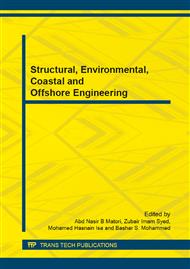[1]
D. M. Necsoiu, A Data Fusion Framework for Floodplain Analysis using GIS and Remotely Sensed Data. (2000).
Google Scholar
[2]
J. Cosgrave, Decision making in emergencies, Disaster Prev. Manage., vol. 5, pp.28-35, (1996).
Google Scholar
[3]
J. K. Levy and K. Taji, Group decision support for hazards planning and emergency management: A Group Analytic Network Process (GANP) approach, Math. Comput. Model., vol. 46, pp.906-917, (2007).
DOI: 10.1016/j.mcm.2007.03.001
Google Scholar
[4]
N. R. F. Maier, Problem-Solving Discussions and Conferences: Leadership Methods and Skills. McGraw-Hill New York, (1963).
Google Scholar
[5]
T. L. Saaty , The Analytic Hierarchy Process: Planning, Priority Setting, Resource Allocation. McGraw-Hill, New York., (1980).
Google Scholar
[6]
T. L. Saaty, Fundamentals of Decision Making and Priority Theory with the Analytic Hierarchy Process. RWS publications Pittsburgh, (1994).
Google Scholar
[7]
T. L. Saaty and G. Hu, Ranking by eigenvector versus other methods in the analytic hierarchy process, Applied Mathematics Letters, vol. 11, pp.121-125, (1998).
DOI: 10.1016/s0893-9659(98)00068-8
Google Scholar
[8]
E. W. L. Cheng and H. Li, Analytic hierarchy process: an approach to determine measures for business performance, Measuring Business Excellence, vol. 5, pp.30-37, (2001).
DOI: 10.1108/eum0000000005864
Google Scholar
[9]
G. Coyle, The Analytic Hierarchy Process, Practical Strategy. Open Access Material, AHP, (2004).
Google Scholar
[10]
M. Modarres, S. Sadi-Nezhad and F. Arabi, Fuzzy analytical hierarchy process using preference ratio: A case study for selecting management short course in a business school, International Journal of Industrial Engineering Computations, vol. 1, pp.173-184, (2010).
DOI: 10.5267/j.ijiec.2010.02.006
Google Scholar
[11]
D. C Chen,., P. C Chen,., Y. C Lee,., S. U You,. and H. C Jao,., Using an analytic hierarchy process to develop competencies on mould product creativity for vocational college students. World Transactions on Engineering and Technology Education (WIETE) , vol. 9, pp.54-59, (2011).
Google Scholar
[12]
D Emmanouloudis, D Myronidis, K Ioannou, Assessment of flood risk in Thasos Islandwith the combined use of multicriteria analysis ΑHP and Geographical Information System. Innovative Applications of Informatics in Agriculture and Environment , vol. 2, pp.103-115 ESRI, (2008).
Google Scholar
[13]
R Sinha, G Bapalu, L Singh, B Rath, Flood risk analysis in the Kosi river basin, northBihar using multi-parametric approach of analytical hierarchy process (AHP). Journal of IndianSociety of Remote Sensing, vol. 36, pp.335-349, (2008).
DOI: 10.1007/s12524-008-0034-y
Google Scholar
[14]
V Meyer, S Scheuer, D Haase, A multicriteria approach for flood risk mapping exemplifiedat the Mulde river, Germany. Natural Hazards , vol. 48, pp.17-39, (2009).
DOI: 10.1007/s11069-008-9244-4
Google Scholar
[15]
F. C Dai,., C. F Lee,., X. H Zhang,., Assessment of landslide susceptibility on the natural terrain of Lantau Island, Hong Kong. Environmental Geology , vol. 61, pp.257-271, 2001b.
DOI: 10.1007/s002540000163
Google Scholar
[16]
B. Pradhan, Flood susceptible mapping and risk area delineation using logistic regression, GIS and remote sensing, Journal of Spatial Hydrology, vol. 9, (2010).
Google Scholar
[17]
S. Yahaya, N. Ahmad and R. Abdalla, Multicriteria analysis for flood vulnerable areas in Hadejia-Jama'are River basin, Nigeria, European Journal of Scientific Research, vol. 42, pp.71-83, (2010).
Google Scholar
[18]
J. R. Eastman, Multi-criteria Evaluation and Geographical Information Systems Eds. Longley PA, Goodchild MF, Magurie DJ and Rhind DW, Second ed. John Wiley and sons, New York, vol. 1, pp.493-502., (1996).
Google Scholar
[19]
R. R. Navalgund, Revised Development plan of Ahmedabad Urban Development Authority Area – 2011. Ahmedabad Urban Development Authority and Space applications Centre, Ahmedabad, India, Technical, Report 1 SAC/RSAG/TR/12/AUG/1997, p.142, (1997).
Google Scholar
[20]
J. Malczewski , GIS and Multicriteria decision analysis. John Wiley and Sons, Inc. United States of America, , pp. pp.177-192., (1999).
Google Scholar
[21]
S. Drobne and A. Lisec, Multi-attribute decision analysis in GIS: weighted linear combination and ordered weighted averaging, Nature, vol. 4, p.28, (2009).
Google Scholar
[22]
H. Simon, The new science of management decisionPrentice-Hall, Englewood Cliffs, NJ, (1977).
Google Scholar


